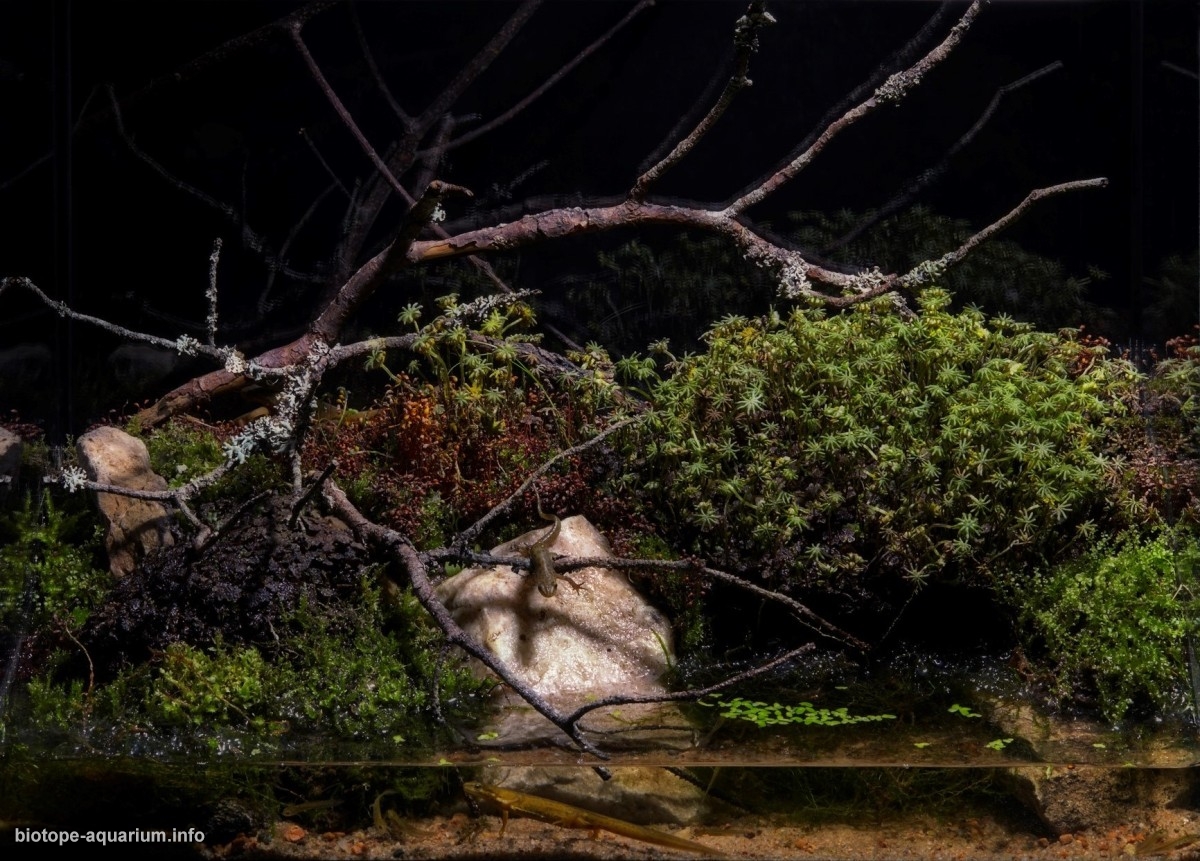Drying roadside drain, Vyakhtelevo village, Gatchina district, Leningrad region, Russia
54th place in Biotope Aquarium Design Contest 2019
Russia. Yegor Tormosov

Volume: 30 L
Dimensions: 42x36x27 cm
List of fishes: Lissotriton vulgaris
List of plants: Marchantia polymorpha, Pohlia sp., Plagiomnium sp.
Description of decorations: Fine beige sand, light limestone, dry willow branches.
Description of equipment: Lighting: LED 6W.
Water parameters: Temperature: 24°C, pH 6.7, KH 5, NO3 15 mg/L, NO2 0.
Additional info: Water change of 1/2 volume of water was carried out 2-3 times a week. This aquaterrarium was designed for an exhibition of amphibians, newts and larvae were exhibited in it for 3 weeks, and then were returned to their natural habitat. The aquaterrarium itself continues to exist, all the mosses planted in it feel good. The aquaterrarium has been functioning for a month and a half. Newts come to a ditch only for spawning time. We have it from the beginning of April to the middle of July. Then they leave for the winter for the rest of summer and winter.
INFORMATION ABOUT BIOTOPE
Description of the area surrounding the biotope: This roadside ditch is an artificial pond, its dimensions are 4×3 meters in the most full-flowing period, and the depth reaches 1.5 meters. The pond is open to the sun. There are no shaded areas. The ditch is located slightly below the water level of the nearby Izhora River. Therefore, in the spring, usually in April, it overflows with water from the river. Then the newts go there to spawn. In addition to newts, here you can find many other aquatic organisms: crustaceans, dragonfly larvae and other insects, snails. The ditch dries almost completely in late July or early August. At this time, newts and metamorphosed larvae leave it. Willow trees and berry bushes grow near the pond, but they almost do not obscure the pond itself. On the banks the cattail grows. Also near the pond there are a lot of mosses. In the design of the aquarium, those mosses that I found along the shores of the reservoir were used.
Description of the underwater landscape of the biotope: There are a lot of willow twigs and driftwood in the water. Willow trees, berry bushes grow near the pond. Also near the pond there are a lot of mosses. In the design of the aquarium, those mosses that I found along the shores of the reservoir were used. The pond was created in an area where there is a lot of limestone, so there are light stones. At the bottom there is fine beige sand washed from the soil.
Description of the parameters of the habitat: The water is clear with a slight yellow tint. Temperature in summer is 18 – 25°C, depending on weather, pH 7.7, KH 10, NO3 – 15 mg/l, NO2 – 0.
List of fishes and invertebrates occurring in the nature biotope: Lissotriton vulgaris, Cyclopidae, Cordulia aenea, Enallagma cyathigerum, Pisidium.
List of plants found in the nature biotope: Above water: Typha latifolia, Marchantia polymorpha, Pohlia sp., Plagiomnium sp. Under water: Fontinalis dalecarlica, Lemna minor, Spirogyra.
Threats to the ecology: This year, newts multiplied little. They became significantly less than before. They disappeared from many ponds and ditches. Having created this aquarium, I am going to show people that it is necessary to protect even the smallest reservoirs with these wonderful creatures. By the way, neighbors buried our ditch this year. I am very sorry that we will no longer have newts.
Sources of information:
http://www.rus-nature.ru/12amf/12.htm
https://amphibiaweb.org/species/4303
http://www.rus-nature.ru/05moss/009.htm
https://www.gbif.org/species/5282603
http://www.efloras.org/florataxon.aspx?flora_id=1&taxon_id=250099103
http://nataboa.blogspot.com/2008/11/plagiomnium-sp.html
http://www.rus-nature.ru/09water/08dvustvorch.htm
https://ru.wikipedia.org/wiki/Бабка_бронзовая
https://ru.wikipedia.org/wiki/Стрелка_голубая
http://ecosystema.ru/08nature/w-invert/086.htm
https://vk.com/wall-85203328_1452
https://vk.com/ebc_aquariumistika
